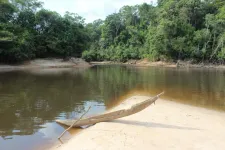INFORMATION:
The experiments were conducted by researchers from the Center for Free-Electron Laser Science (CFEL), a collaboration between DESY, the University of Hamburg and the Max Planck Society, as well as a colleague from the Lawrence Berkeley Laboratory in California.
Plasma acceleration: It's all in the mix
A pinch of nitrogen and artificial intelligence are moving laser plasma acceleration a big step closer to practical applications
2021-04-27
(Press-News.org) The LUX team at DESY is celebrating not just one but two milestones in the development of innovative plasma accelerators. The scientists from the University of Hamburg and DESY used their accelerator to test a technique that allows the energy distribution of the electron beams produced to be kept particularly narrow. They also used artificial intelligence to allow the accelerator to optimise its own operation. The scientists are reporting their experiments in two papers published shortly after one another in the journal Physical Review Letters. "It's fantastic to see the speed with which the new technology of plasma acceleration is reaching a level of maturity where it can be used in a wide range of applications," congratulates Wim Leemans, Director of the Accelerator Division at DESY.
Plasma acceleration is an innovative technology that is giving rise to a new generation of particle accelerators which are not only remarkably compact but also extremely versatile. The aim is to make the accelerated electrons available for applications in various different fields of industry, science and medicine.
The acceleration takes place in a tiny channel, just a few millimetres long, filled with an ionised gas called a plasma. An intense laser pulse generates a wave within the channel, which can capture and accelerate electrons from the plasma. "Like a surfer, the electrons are carried along by the plasma wave, which accelerates them to high energies," explains Manuel Kirchen, lead author of one of the papers. "Using this technique, plasma accelerators are able to achieve accelerations that are up to a thousand times higher than those of the most powerful machines in use today," adds Sören Jalas, author of the second paper.
However, this compactness is both a curse and a blessing: since the acceleration process is concentrated in a tiny space that is up to 1000 times smaller than conventional, large-scale machines, the acceleration takes place under truly extreme conditions. Therefore, a number of challenges still have to be overcome before the new technology is ready to go into series production.
The research team led by Andreas Maier, an accelerator physicist at DESY, has now reached two critical milestones at the LUX test facility - jointly operated by DESY and the University of Hamburg: they have found a way of significantly reducing the energy distribution of the accelerated electron bunches - one of the most essential properties for many potential applications. To do this, they programmed a self-learning autopilot for the accelerator, which automatically optimises LUX for maximum performance.
The group conducted its experiments using a new type of plasma cell, specially developed for the purpose, whose plasma channel is divided into two regions. The plasma is generated from a mixture of hydrogen and nitrogen in the front part of the cell, which is about 10 millimetres long, while the region behind it is filled with pure hydrogen. As a result, the researchers were able to obtain the electrons for their particle bunch from the front part of the plasma cell, which were then accelerated over the entire rear section of the cell. "Being more tightly bound, the electrons in the nitrogen are released a little later, and that makes them ideal for being accelerated by the plasma wave," explains Manuel Kirchen. The electron bunch also absorbs energy from the plasma wave, changing the shape of the wave. "We were able to take advantage of this effect and adjust the shape of the wave so that the electrons reach the same energy regardless of their position along the wave," adds Kirchen.
Based on this recipe for achieving high electron beam quality, the team then scored a second research success: Sören Jalas and his colleagues were able to use artificial intelligence (IA) to modify an algorithm that controls and optimises the complex system of the plasma accelerator. To do so, the scientists provided the algorithm with a functional model of the plasma accelerator and a set of adjustable parameters, which the algorithm then optimised on its own. Essentially, the system modified five main parameters, including the concentration and density of the gases and the energy and focus of the laser, and used the resulting measurements to search for an operating point at which the electron beam has the optimum quality. "In the course of its balancing act in 5-dimensional space, the algorithm was constantly learning and very quickly refined the model of the accelerator further and further," says Jalas. "The AI takes about an hour to find a stable optimum operating point for the accelerator; by comparison, we estimate that human beings would need over a week."
A further advantage is that all the parameters and measured variables continue to train the accelerator's AI model, making the optimisation process faster, more systematic and more targeted. "The latest progress at LUX means we are well on the way to trying out initial applications for test purposes," explains Andreas Maier, who is in charge of developing lasers for plasma accelerators at DESY. "Ultimately, we also want to use plasma-accelerated electron bunches to operate a free-electron laser."
ELSE PRESS RELEASES FROM THIS DATE:
Cholestenone shows antibiotic properties against H. pylori
2021-04-27
Helicobacter pylori (H. pylori), a gram-negative pathogen that has infected half of the world's population is a Group I carcinogen according to the WHO. H. pylori resides in the gastric mucosa causing gastritis, ulcers, gastric cancers and malignant lymphoma of the stomach. It can be eradicated in most infected people using a combination of three drugs; antibiotics clarithromycin, amoxicillin, and gastric acid suppressants. Amoxicillin exerts antibacterial activity by inhibiting the biosynthesis of peptidoglycan present in the cell wall of bacteria, and clarithromycin exerts antibacterial activity by inhibiting protein synthesis.
The current success rate of H. pylori eradication is about 90%. ...
Value from sewage? New technology makes pig farming more environmentally friendly
2021-04-27
Anyone who lives in Okinawa, a subtropical island in Japan, has an appreciation of the intensity of its pig farming industry. The farms have a large effect on the island's economy and culture. According to Japan's Cabinet Office, as of 2018, there were over 225,000 pigs in Okinawa. Pork is a staple in the local diet and is found in many dishes in traditional restaurants. But the presence of the pig farms has another, less welcome, impact - the odor-y kind. Drive through some particularly farm-filled areas with the car's windows wound down and you're sure to be filled with regret.
This smell is, at least in part, caused by a byproduct of the pig farming. ...
Future drones likely to resemble 300-million-year-old flying machine
2021-04-27
University of South Australia researchers have drawn inspiration from a 300-million-year-old superior flying machine - the dragonfly - to show why future flapping wing drones will probably resemble the insect in shape, wings and gearing.
A team of PhD students led by UniSA Professor of Sensor Systems, Javaan Chahl, spent part of the 2020 COVID-19 lockdown designing and testing key parts of a dragonfly-inspired drone that might match the insect's extraordinary skills in hovering, cruising and aerobatics.
The UniSA students worked remotely on the project, solving mathematical formulas at home on whiteboards, digitising stereo photographs of insect wings into 3D models, and using spare rooms as rapid prototyping workshops to test parts of the flapping wing drone.
Their findings have ...
Loss of fauna in tropical forests impedes achieving Sustainable Development Goals
2021-04-27
The current loss of biological diversity is unprecedented and species extinctions exceed the estimated background rate many times over. Coinciding with increasing human domination and alteration of the natural world, this loss in abundance and diversity is especially pronounced with - but not limited to - fauna in the tropics. A new publication from scientists at the Lund University Centre for Sustainability Studies (LUCSUS) in Sweden and the Leibniz Institute for Zoo and Wildlife Research (Leibniz-IZW) in Germany now explores the links between defaunation of tropical forests and the United ...
The bluest of blue: A new algae-based switch is lighting up biological research!
2021-04-27
Several organisms possess "ion channels" (gateways that selectively allow charged particles called ions to enter the cells and are integral for cell function) called "channelrhodopsins," that can be switched on and off with the help of light. Different channelrhodopsins respond to different wavelengths in the light spectrum. These channels can be expressed in foreign organisms (animals even in human) by means of genetic engineering, which in turn finds applications in optogenetics, or the application of light to modulate cellular and gene functions. So far, the shortest wavelength that a channelrhodopsin ...
New research on why mutations in a gene leads to mitochondrial disease
2021-04-27
Monash University researchers have uncovered for the first time the reason mutations in a particular gene lead to mitochondrial disease.
The finding, published in PNAS journal and led by Professor Mike Ryan from Monash University's Biomedicine Discovery Institute, shows that a gene responsible for causing loss of vision and hearing, TMEM126A, makes a protein that helps build an important energy generator in mitochondria. So, if this gene is defective, it reduces mitochondrial function and impares energy production, uncovering why mutations lead to the disease.
Mitochondria are critical structures within ...
Portopulmonary hypertension in patients with chronic liver disease
2021-04-27
Portopulmonary hypertension (PoPH) is a form of pulmonary arterial hypertension (PAH). PoPH occurs in approximately 15% of patients with PAH, and is reportedly found in 2-6% of patients with portal hypertension and 1-2% of patients with liver cirrhosis according to studies from Europe and America. However, the real-world data on PoPH in Japan are largely unknown, with many questions on the condition's etiology and prevalence.
Led by doctorate student Shun-ichi Wakabayashi of Shinshu University, the goal of this investigation is to clarify the actual state of PoPH among patients with chronic liver disease by screening all such patients treated at Shinshu University Hospital.
Although there is considerable uncertainty on the impact of PoPH, it is known that ...
New clues on how networks such as Twitter are organized to respond to viral news
2021-04-27
Examples of complex systems exist everywhere. Neuron connections and protein-protein interactions are two systems of this type found in organisms, but complex systems also exist in cities, economic models, and even in social networks. The common denominator is that they are made up of many interrelated elements which can be represented and studied as a network.
For more than a decade, scientists have been studying the possibility of finding more than one type of structural organization within a single network, and this is the subject of the doctoral thesis defended by María José Palazzi, as part of the UOC's doctoral programme in Network and Information Technologies. ...
International research team discovers new two-dimensional material
2021-04-27
An international team with researchers from the University of Bayreuth has succeeded for the first time in discovering a previously unknown two-dimensional material by using modern high-pressure technology. The new material, beryllonitrene, consists of regularly arranged nitrogen and beryllium atoms. It has an unusual electronic lattice structure that shows great potential for applications in quantum technology. Its synthesis required a compression pressure that is about one million times higher than the pressure of the Earth's atmosphere. The scientists have presented their discovery in the journal Physical Review Letters.
Since the discovery of graphene, which is made of carbon atoms, interest in two-dimensional ...
Scientists created technology to detect and treat complex arrhythmias
2021-04-27
Researchers from Belgium, the Netherlands, Russia, and Italy have developed a breakthrough method for quickly, accurately, and reliably diagnosing cardiac arrhythmias. They called it Directed graph mapping (DGM). The technology principles are published in JACC: Clinical Electrophysiology.
One of the members of the research team is Alexander Panfilov, leading specialist of the laboratory of computational biology and medicine at Ural Federal University (Russia), head of the biophysics group at the University of Ghent (Belgium), professor at the Department of Cardiology at Leiden University (Netherlands). The research was led ...
LAST 30 PRESS RELEASES:
Study uncovers disrupted brain balance in alcohol dependence
Working in groups can help Republicans and Democrats agree on controversial content moderation online
Structural findings reveal how distinct GPCR ligands create different levels of activation
Anything-goes “anyons” may be at the root of surprising quantum experiments
UC review: Maximizing workplace opportunity for veterans
From generation to complex control: Metasurfaces make perfect vortex beams "within reach"
Thin-film lithium niobate-based detector: recent advances and perspectives
Exploring why some people may tend to persistently make bad choices
How cells balance their protein levels
Nirsevimab vs RSVpreF vaccine for RSV–related hospitalization in newborns
Effectiveness and impact of maternal RSV immunization and nirsevimab on medically attended RSV in US children
AI gives scientists a boost, but at the cost of too many mediocre papers
Next-generation vision model maps tree growth at sub-meter precision
Genes aren’t destiny for inherited blindness, study shows
MIT study: High-fat diets make liver cells more likely to become cancerous
Exposure to multiple fine particulate matter components and incident depression in the US Medicare population
Risk of burdensome health care spending over time in the US
Nirsevimab against hospitalizations and emergency department visits for lower respiratory tract infection in infants
New microfluidics technology enables highly uniform DNA condensate formation
A new strategy for immune tolerance
Super Mario Bros. help fight burnout: New study links classic games to boosted happiness
Deepest gas hydrate cold seep ever discovered in the arctic: International research team unveils Freya Hydrate Mounds at 3,640 m depth.
Integrating light and structure: Smarter mapping for fragile wetland ecosystems
ACA-SIM: A robust way to decode satellite signals over complex waters
Probiotics can restore gut microbiome in breastfed infants
AI could help predict nutrition risks in ICU patients, study finds
Federal EITC has unexpected result, researchers say – it decreases domestic violence
Researchers identify gene that calms the mind and improves attention in mice
Artificial metabolism turns waste CO2 into useful chemicals
Ancient sea anemone sheds light on animal cell type evolution
[Press-News.org] Plasma acceleration: It's all in the mixA pinch of nitrogen and artificial intelligence are moving laser plasma acceleration a big step closer to practical applications







